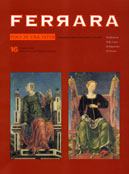However, a new awareness of the Fondazione's possible role quickly developed among the staff involved: they became increasingly convinced that they could give an impetus to important initiatives for local growth and human, cultural and economic development, by redistributing income from banking activities in the various geographical areas in question back into civil society. A detailed account of the Fondazione's cultural policy over the last ten years leads us along a symbol-strewn path, bringing to mind those cross-roads, key moments, and significant stages at which the regeneration process had a significant impact in concrete terms, even if not a spectacular one.
To offer mankind the chance to contemplate beauty is to give him the greatest of gifts. As Plato was the first to understand, the great importance of beauty is that it can be perceived physically as well as spiritually. The soul perceives beauty through the eyes of the body, and man thus experiences the oneness of body and soul.
Although Ercole I d'Este had not read Plato, in allowing the Lateran canons to build a new and spacious church in place of the crumbling building in which the first miracle of the Eucharist occurred on 28 March 1171 - entrusting the work to the painter Ercole de' Roberti and the engineer Biagio Rossetti - he was utterly convinced of the value of art and architecture, in short of beauty, which could convey powerful emotions spanning time and space. It is therefore easy to understand the speed with which the Fondazione responded, in 1993, to the obvious need for restoration, and the unquestionable firm commitment with which it has supported the renovation of the church.
If one of the museum's chief aims is to bring home Ferrara's artistic heritage, it has found an invaluable ally in the Fondazione. One of its first acts was to buy 23 paintings at Sotheby's, formerly part of the notable collection owned by the Marchese Massimiliano Sacrati Strozzi (1797-1859), which have joined another set which had already been hanging for some years in the Pinacoteca. Among the paintings bought in London were works by Battista Dossi, Scarsellino, Biagio d'Antonio, Giovanni di Pietro Falloppi and four panels definitively attributed to El Greco.
The Fondazione has bought numerous collections or single paintings linked to Ferrara's history and culture for display in the Pinacoteca - including the Garofalo Crucifixion, Scarsellino's Allegorical scenes, Carlo Bononi's Holy Family and San Giovannino, Niccolò Pisano's Adoration of the Magi, and Jacob and Rachel at the well by the "Maestro dei Dodici Apostoli". In so doing it has performed a significant service, as if restoring the ideal image of the city which had been enfeebled by successive losses.
Yet the opposite of "divide AND destroy" is "reunite AND rebuild." And philological debate is one way of piecing together the mosaic. This was shown in the major exhibition, La leggenda del Collezionismo, held in 1996, examining the fundamental and complex phenomenon of collecting in Ferrara, a balance between the satisfactions of ownership and the æsthetic pleasures of knowledge.
The legendary aura of the Ferrara of dreams, commemorated by nineteenth century collectors, evokes the city under d'Este rule, the "capital OF the renaissance" where art, music and literature are intertwined like threads in a great tapestry. The paintings gathered together, displayed and organised in an original fashion, attempted to reconstruct vanished places such as Leonello's Belfiore study and the sumptuous apartments of Alfonso I in the Castello.



